#garment alterations victoria
Explore tagged Tumblr posts
Text
Leons Dry Cleaners: Your One-Stop Solution for Garment and Household Cleaning

Maintaining cleanliness and preserving the quality of clothes, curtains, and household items is essential for both aesthetics and hygiene. At Leons Dry Cleaners, we understand the importance of professional cleaning and provide a wide range of services, including laundry services in The Hague, dry cleaning in London, wedding dress dry cleaning, curtain cleaning services, and household cleaning solutions in Victoria, South West London.
In this comprehensive guide, we’ll explore these services in detail, explain their importance, and answer some of the most frequently asked questions about professional cleaning.
1. Laundry Services in The Hague: Convenience and Quality Combined
For busy professionals, families, or anyone managing hectic schedules, laundry can become an overwhelming task. This is where Leons Dry Cleaners steps in with premium laundry services in The Hague.
Why Choose Professional Laundry Services?
Professional laundry services save time while ensuring thorough cleaning. Here’s what makes Leons Dry Cleaners stand out:
Advanced Cleaning Techniques: High-quality detergents and state-of-the-art machines ensure deep cleaning without damaging delicate fabrics.
Eco-Friendly Approach: We use environmentally safe products, reducing harm to the planet while keeping your clothes fresh.
Convenience: With pickup and delivery services, we make laundry hassle-free.
Specialized Laundry Solutions
Whether it’s delicate fabrics, heavily soiled clothes, or special items like duvets and blankets, our expertise ensures your garments come back spotless and well-maintained.
2. Dry Cleaning in London: Perfect for Delicate and High-End Fabrics
Dry cleaning is a necessity for garments that require extra care, such as formal suits, evening gowns, and woolen jackets. Leons Dry Cleaners in London offers unmatched expertise in handling these items.
The Science Behind Dry Cleaning
Unlike traditional washing, dry cleaning in London uses solvents instead of water to remove stains, grease, and dirt without affecting the garment’s fabric or shape. This process is ideal for:
Wool and cashmere garments.
Silk dresses and ties.
Embellished or embroidered clothing.
Our Promise of Quality
At Leons Dry Cleaners, we ensure:
Removal of tough stains while preserving fabric integrity.
Restoration of garments to their original look and feel.
Quick turnaround times for busy Londoners.

3. Wedding Dress Dry Cleaning: Safeguarding Precious Memories
Your wedding dress is one of the most significant pieces of clothing you’ll ever own. Preserving its beauty requires specialized cleaning techniques, and Leons Dry Cleaners is the trusted name for wedding dress care.
Why Professional Wedding Dress Cleaning is Essential
Wedding dresses are often made with delicate fabrics like lace, satin, and chiffon, adorned with intricate embellishments. These require professional handling to avoid damage.
How Leons Dry Cleaners Handles Wedding Dresses
Comprehensive Inspection: We carefully examine the dress for stains, wear, and embellishment conditions.
Custom Cleaning Methods: Using advanced, fabric-specific techniques, we gently remove stains and restore the dress to its original glory.
Preservation Packaging: After cleaning, we offer acid-free storage boxes to protect the dress from discoloration and aging.
Our services are tailored to ensure your wedding gown remains as radiant as your memories of the day.
4. Curtain Cleaning Service in Victoria, South West London
Curtains are often overlooked during routine cleaning, yet they accumulate dust, allergens, and odors over time. Professional curtain cleaning service in Victoria, South West London not only revitalizes their appearance but also contributes to a healthier indoor environment.
Why Professional Curtain Cleaning Matters
Improves Air Quality: Regular cleaning removes allergens and pollutants trapped in the fabric.
Extends Fabric Life: Professional cleaning prevents wear and tear caused by accumulated dirt.
Enhances Appearance: Restores the color and texture of your curtains, making them look as good as new.
Leons Dry Cleaners: Your Curtain Care Experts
In Victoria, South West London, we specialize in:
Cleaning all types of curtains, including silk, velvet, and synthetic blends.
Removing tough stains while maintaining fabric integrity.
Rehanging services to make the process seamless for you.

5. Household Cleaning Services in Victoria, South West London
Maintaining a clean and comfortable home can be challenging, especially for those with busy lifestyles. Leons Dry Cleaners offers a comprehensive range of household cleaning services to ensure your living space stays fresh and welcoming.
What We Offer
Carpet and Rug Cleaning: Eliminate dirt, stains, and allergens with deep-cleaning solutions.
Upholstery Cleaning: Restore sofas, chairs, and cushions to their original look.
Linen and Bedding Care: Professional washing and steaming for sheets, duvets, and pillowcases.
Benefits of Professional Household Cleaning
Saves time and effort.
Ensures a healthier living environment by removing allergens and bacteria.
Prolongs the life of household items like carpets and upholstery.
Leons Dry Cleaners’ household cleaning services are designed to meet your specific needs, offering both convenience and exceptional results.
FAQs: Everything You Need to Know About Our Dry Cleaning Services
1. How often should I use professional laundry services?
This depends on your needs. Weekly services are ideal for those with busy schedules, while occasional deep cleaning is perfect for seasonal items like jackets and blankets.
2. Is dry cleaning safe for all fabrics?
Yes, dry cleaning is particularly safe for delicate and high-end fabrics. At Leons Dry Cleaners, we assess every item to determine the best cleaning method.
3. How do I prepare my wedding dress for cleaning?
Avoid wrapping it in plastic, as this can trap moisture and cause yellowing. Bring the dress to us as soon as possible to address stains before they set.
4. Can curtain cleaning be done on-site?
Yes, we offer on-site cleaning services for curtains, ensuring minimal disruption to your home.
5. Are your household cleaning products eco-friendly?
Absolutely! We prioritize eco-friendly solutions to ensure safe and sustainable cleaning practices.
6. How long does wedding dress cleaning take?
Depending on the condition and complexity of the dress, the process typically takes 7–10 days.
Why Choose Leons Dry Cleaners?
Leons Dry Cleaners has built a reputation for excellence in garment and household cleaning. Here’s why customers trust us:
Experience and Expertise: Decades of experience in handling delicate fabrics and intricate designs.
Tailored Solutions: Services customized to meet individual needs.
Convenience: Pickup, delivery, and on-site services available for your ease.
Eco-Friendly Practices: Commitment to sustainable and safe cleaning methods.
Conclusion
Leons Dry Cleaners is more than just a cleaning service; it’s a partner dedicated to keeping your garments and household items in perfect condition. Whether you need reliable laundry services in The Hague, expert dry cleaning in London, or specialized care for wedding dresses, curtains, and household items in Victoria, South West London, we’ve got you covered.
Contact Leons Dry Cleaners today and experience unparalleled quality and convenience in cleaning services!
#south west london#wedding dress dry cleaning#household cleaning services victoria#delicate dress cleaners victoria#curtain cleaning service victoria#garment alterations victoria#leather cleaning service victoria#dry cleaning pick up and delivery victoria
0 notes
Text

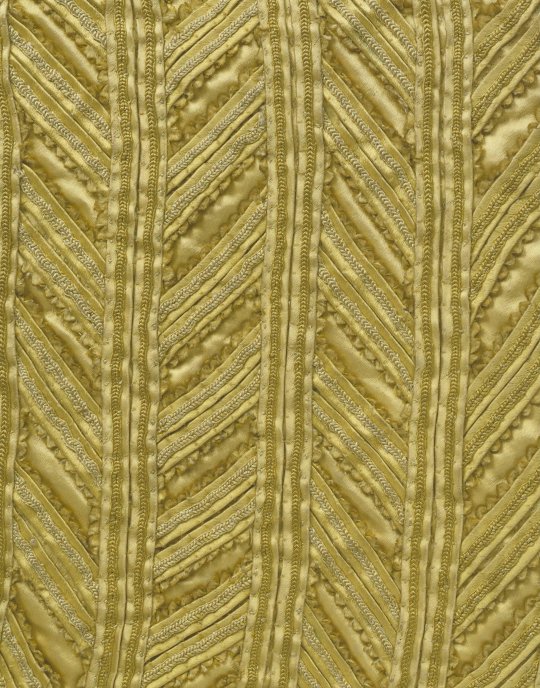
Ensemble
1630s
England
This ensemble demonstrates fashionable formal dress for men in the 1630s. The breeches are long and fairly full in cut, reaching just below the knee. The doublet has a high waist at the sides and back, extending to a point in front. A deliberate opening of the seam on each sleeve allows the fine linen shirt underneath to be seen. No ensemble was complete without a cloak, and this example spans almost a full circle. The ornamental technique used on this outfit is unique and complicated. Braided silk threads were couched to narrow bias strips of satin which were sewn to a wider satin strip, pinked on each side. Then they were cut into short pieces and arranged vertically and diagonally over the satin surfiace of each garment to create a decorative effect that, from a distance, looks like slashing. The cape [flat collar] of the cloak has been altered at a later date.
The Victoria & Albert (Accession number: T.58 to B-1910)
#ensemble#menswear#fashion history#historical fashion#1630s#17th century#stuart era#breeches#doublet#yellow#silk#england#united kingdom#v and a
376 notes
·
View notes
Text
Mourning Dress, British, 1894
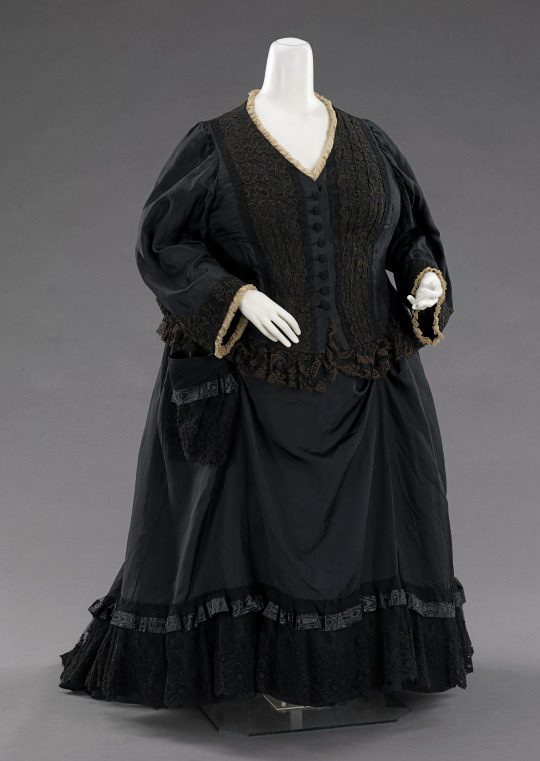
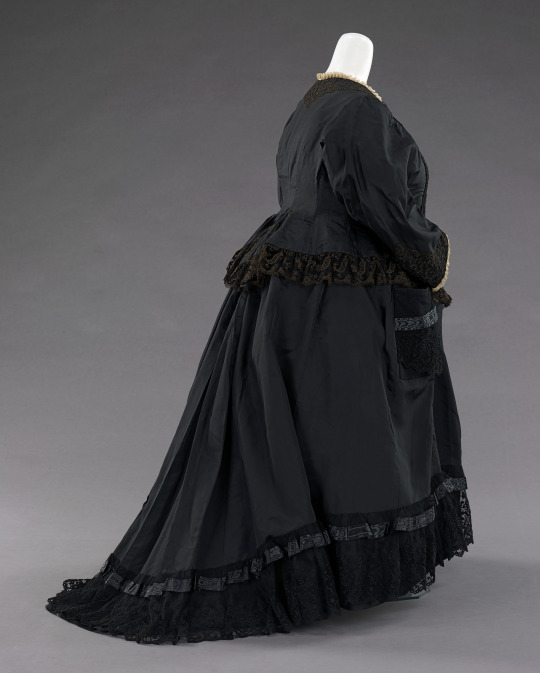
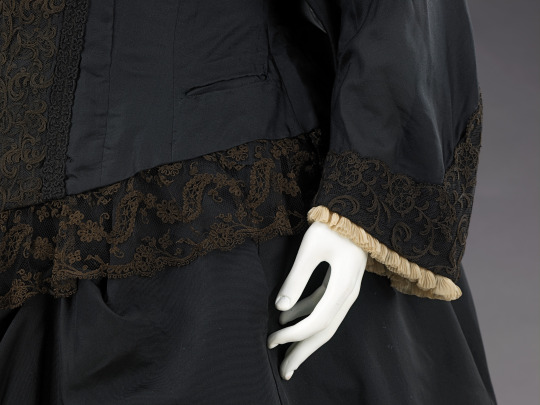

This dress was once worn by Queen Victoria (1819-1901) of the United Kingdom, as documented in an 1894 photograph of the Queen holding her great-grandson, Edward VIII (1894-1972). Purchased from an annual sale of the Queen's garments, it shows the traditional touches of mourning attire, which she wore from the death of her husband, Prince Albert (1819-1861), until her own death. The simple white trim and minimal use of crinkled crepe on the dress indicate a state of half mourning, although it is 33 years after her husband's death. The bodice is of a lighter material to allow for comfort during summer months and the entire garment is finely detailed inside and out. Black mourning dress reached its peak during Queen Victoria's reign. She set the standard by wearing mourning for half of her life. With these standards in place, it was considered a social requisite to don black from anywhere between three months to two and a half years while grieving for a loved one or monarch. The stringent social custom existed for all classes and was available at all price points. Those who could not afford the change of dress often altered and dyed their regular garments black. The amount of black to be worn was dictated by several different phases of mourning; full mourning ensembles were solid black while half mourning allowed the wearer to add a small amount of white or purple.
The MET Museum
59 notes
·
View notes
Text
⏳ 𝔗𝔦𝔪𝔢 𝔖𝔲𝔰𝔭𝔢𝔫𝔡𝔢𝔡 ⏳
absolutely LOSING MY MIND over this steampunk hourglass corset??? the perfect blend of victorian silhouette and mechanical precision has me questioning my entire existence?? the way the metal boning creates that immaculate hourglass shape while the rich brown leather embraces vintage industrial aesthetics?? i'm having heart palpitations over here 🕰️⚙️✨

ways to style this time-altering masterpiece:
over a billowy white blouse with dramatic sleeves for that "time traveler on a mission" energy
paired with a high-waisted full skirt for classical victorian steampunk perfection
with fitted trousers and boots for that "airship engineer who could also attend a royal ball" vibe
layered over a simple dress to instantly transform it into a portal to another era
perfect scenarios for this temporal wonder:
exploring abandoned clock towers while taking notes in a leather-bound journal attending that underground steampunk soirée where everyone speaks in riddles commanding respect at conventions where people mistake you for the main character casually existing in your apartment while feeling like you could manipulate the very fabric of time
currently calculating how many cups of tea i need to sacrifice from my daily ritual to afford this because apparently my priorities are now: 1) becoming a steampunk time sorceress 2) basic survival needs
does anyone else feel like certain garments don't just change how you look but actually alter the dimension you exist in or is that just me having another aesthetic crisis??
#steampunkcorset #hourglasssilhouette #victoriansteampunk #leathercorset #timekeeper #mechanicalfashion #vintageaesthetic #steampunkfashion #industrialchic #timebender #brassdetails
0 notes
Text
What is an Eco-friendly dry cleaning service?
An Eco-Friendly dry cleaning service is a method of laundry that entails the use of non-harmful substances in dry cleaning your clothes and applying safeguard methods in drying them as well.
Wosh Laundry Services apply such eco-friendly services in their dry cleaning for customers, and one such method is the use of “wet cleaning”.

Why choose Wet Cleaning Dry Cleaning Process?
Wet cleaning is energy-efficient
Due to its revolutionary water and energy efficiencies, the wet cleaning process:
Uses on average 30% less water than the traditional wash cycle in Dry Cleaning
Is able to provide amazing results even at 20 degrees
Reduce energy consumption by up to 50% which makes it a truly green alternative to traditional Dry Cleaning.
Wet cleaning is safer for you and your family
No toxic chemicals are used in our process and instead, we use biodegradable detergents – no PERC is ever needed when you get your clothes cleaned by us.
This means that those chemicals will not enter our air or water supply which makes the environment and planet safer.
It’s also a much better alternative for babies, children, and people who suffer from breathing-related allergies.
Wet cleaning is better for your clothes:
The wet cleaning washer and dryers are highly sophisticated and have control over a range of factors such as:
Detergent dosing levels
Drum rotation rhythms
Water temperature to a very high degree of accuracy
Clothes are cleaned in a safe manner and are left with a fresh smell – no more toxic odors!
The washer also uses an optimized spin cycle that measures the amount of moisture in your clothes which helps protect them from overdrying and therefore less chance of shrinking.
Wet Cleaning is a safer and equally effective way to have your 'dry clean only garments' laundered. This process uses specialized washing programs and designated solvents to give you clean and well-preserved garments.
Apart from the use of insensitive detergents and organic agents to help improve the life span of your clothes during the wear and tear process of the routine wash cycle, Wosh laundry services by The Rhodesbox are top-notch in the field of Laundromat services, as their business cut across the following;
Repairs and alterations: In this case due to the fabric wear and tear engineering, cloths are subject to being torn or damaged. Wosh laundry service looks into such repairs and alterations as an added function which should be done by personnel with a keen eye to details, regarding the thread outline of the fabric itself and matching color of the cloth eg not repairing a cloth with an army green color instead of lemon green color.
Rug and upholstery cleaning service: This is another dry cleaning service area we shine with the use of sophisticated washing machines to bring out the shine in your old rugs and make them anew with that adoring fragrance. Wosh Laundry service by The Rhodesbox provides this service with top-notch delivery, especially the removal of dust stains from upholstery furniture at home.
Laundromat cleaning service: With the modernization of things, Wosh Laundromat service is keen to provide flexible hours and package plans that best suit your daily routine for individuals who enjoy the do-it-yourself (DIY) approach to their personnel attires. Using our self-service Laundromat washing machine units, you can rest assured that your dry cleaning will still come out being the best, as our staff is there to provide advice on stubborn stain removal agents and cleaning processes for the best results.
So, if you are looking for a reliable eco-friendly dry cleaning or Laundromat service near you in Lekki, Victoria Island, and Ajah axis, Wosh by Therhodesbox is your professional laundry service business you can go to.
1 note
·
View note
Text
fan language: the victorian imaginary and cnovel fandom
there’s this pinterest image i’ve seen circulating a lot in the past year i’ve been on fandom social media. it’s a drawn infographic of a, i guess, asian-looking woman holding a fan in different places relative to her face to show what the graphic helpfully calls “the language of the fan.”
people like sharing it. they like thinking about what nefarious ancient chinese hanky code shenanigans their favorite fan-toting character might get up to—accidentally or on purpose. and what’s the problem with that?
the problem is that fan language isn’t chinese. it’s victorian. and even then, it’s not really quite victorian at all.
--------------------
fans served a primarily utilitarian purpose throughout chinese history. of course, most of the surviving fans we see—and the types of fans we tend to care about—are closer to art pieces. but realistically speaking, the majority of fans were made of cheaper material for more mundane purposes. in china, just like all around the world, people fanned themselves. it got hot!
so here’s a big tipoff. it would be very difficult to use a fan if you had an elaborate language centered around fanning yourself.
you might argue that fine, everyday working people didn’t have a fan language. but wealthy people might have had one. the problem we encounter here is that fans weren’t really gendered. (caveat here that certain types of fans were more popular with women. however, those tended to be the round silk fans, ones that bear no resemblance to the folding fans in the graphic). no disrespect to the gnc old man fuckers in the crowd, but this language isn’t quite masc enough for a tool that someone’s dad might regularly use.
folding fans, we know, reached europe in the 17th century and gained immense popularity in the 18th. it was there that fans began to take on a gendered quality. ariel beaujot describes in their 2012 victorian fashion accessories how middle class women, in the midst of a top shortage, found themselves clutching fans in hopes of securing a husband.
she quotes an article from the illustrated london news, suggesting “women ‘not only’ used fans to ‘move the air and cool themselves but also to express their sentiments.’” general wisdom was that the movement of the fan was sufficiently expressive that it augmented a woman’s displays of emotion. and of course, the more english audiences became aware that it might do so, the more they might use their fans purposefully in that way.
notice, however, that this is no more codified than body language in general is. it turns out that “the language of the fan” was actually created by fan manufacturers at the turn of the 20th century—hundreds of years after their arrival in europe—to sell more fans. i’m not even kidding right now. the story goes that it was louis duvelleroy of the maison duvelleroy who decided to include pamphlets on the language with each fan sold.
interestingly enough, beaujot suggests that it didn’t really matter what each particular fan sign meant. gentlemen could tell when they were being flirted with. as it happens, meaningful eye contact and a light flutter near the face may be a lingua franca.
so it seems then, the language of the fan is merely part of this victorian imaginary we collectively have today, which in turn itself was itself captivated by china.
--------------------
victorian references come up perhaps unexpectedly often in cnovel fandom, most often with regards to modesty.
it’s a bit of an awkward reference considering that chinese traditional fashion—and the ambiguous time periods in which these novels are set—far predate victorian england. it is even more awkward considering that victoria and her covered ankles did um. imperialize china.
but nonetheless, it is common. and to make a point about how ubiquitous it is, here is a link to the twitter search for “sqq victorian.” sqq is the fandom abbreviation for shen qingqiu, the main character of the scum villain’s self-saving system, by the way.
this is an awful lot of results for a search involving a chinese man who spends the entire novel in either real modern-day china or fantasy ancient china. that’s all i’m going to say on the matter, without referencing any specific tweet.
i think people are aware of the anachronism. and i think they don’t mind. even the most cursory research reveals that fan language is european and a revisionist fantasy. wikipedia can tell us this—i checked!
but it doesn’t matter to me whether people are trying to make an internally consistent canon compliant claim, or whether they’re just free associating between fan facts they know. it is, instead, more interesting to me that people consistently refer to this particular bit of history. and that’s what i want to talk about today—the relationship of fandom today to this two hundred odd year span of time in england (roughly stuart to victorian times) and england in that time period to its contemporaneous china.
things will slip a little here. victorian has expanded in timeframe, if only because random guys posting online do not care overly much for respect for the intricacies of british history. china has expanded in geographic location, if only because the english of the time themselves conflated china with all of asia.
in addition, note that i am critiquing a certain perspective on the topic. this is why i write about fan as white here—not because all fans are white—but because the tendencies i’m examining have a clear historical antecedent in whiteness that shapes how white fans encounter these novels.
i’m sure some fans of color participate in these practices. however i don’t really care about that. they are not its main perpetrators nor its main beneficiaries. so personally i am minding my own business on that front.
it’s instead important to me to illuminate the linkage between white as subject and chinese as object in history and in the present that i do argue that fannish products today are built upon.
--------------------
it’s not radical, or even new at all, for white audiences to consume—or create their own versions of—chinese art en masse. in many ways the white creators who appear to owe their whole style and aesthetic to their asian peers in turn are just the new chinoiserie.
this is not to say that white people can’t create asian-inspired art. but rather, i am asking you to sit with the discomfort that you may not like the artistic company you keep in the broader view of history, and to consider together what is to be done about that.
now, when i say the new chinoiserie, i first want to establish what the original one is. chinoiserie was a european artistic movement that appeared coincident with the rise in popularity of folding fans that i described above. this is not by coincidence; the european demand for asian imports and the eventual production of lookalikes is the movement itself. so: when we talk about fans, when we talk about china (porcelain), when we talk about tea in england—we are talking about the legacy of chinoiserie.
there are a couple things i want to note here. while english people as a whole had a very tenuous knowledge of what china might be, their appetites for chinoiserie were roughly coincident with national relations with china. as the relationship between england and china moved from trade to out-and-out wars, chinoiserie declined in popularity until china had been safely subjugated once more by the end of the 19th century.
the second thing i want to note on the subject that contrary to what one might think at first, the appeal of chinoiserie was not that it was foreign. eugenia zuroski’s 2013 taste for china examines 18th century english literature and its descriptions of the according material culture with the lens that chinese imports might be formative to english identity, rather than antithetical to it.
beyond that bare thesis, i think it’s also worthwhile to extend her insight that material objects become animated by the literary viewpoints on them. this is true, both in a limited general sense as well as in the sense that english thinkers of the time self-consciously articulated this viewpoint. consider the quote from the illustrated london news above—your fan, that object, says something about you. and not only that, but the objects you surround yourself with ought to.
it’s a bit circular, the idea that written material says that you should allow written material to shape your understanding of physical objects. but it’s both 1) what happened, and 2) integral, i think, to integrating a fannish perspective into the topic.
--------------------
japanning is the name for the popular imitative lacquering that english craftspeople developed in domestic response to the demand for lacquerware imports. in the eighteenth century, japanning became an artform especially suited for young women. manuals were published on the subject, urging young women to learn how to paint furniture and other surfaces, encouraging them to rework the designs provided in the text.
it was considered a beneficial activity for them; zuroski describes how it was “associated with commerce and connoisseurship, practical skill and aesthetic judgment.” a skillful japanner, rather than simply obscuring what lay underneath the lacquer, displayed their superior judgment in how they chose to arrange these new canonical figures and effects in a tasteful way to bring out the best qualities of them.
zuroski quotes the first english-language manual on the subject, written in 1688, which explains how japanning allows one to:
alter and correct, take out a piece from one, add a fragment to the next, and make an entire garment compleat in all its parts, though tis wrought out of never so many disagreeing patterns.
this language evokes a very different, very modern practice. it is this english reworking of an asian artform that i think the parallels are most obvious.
white people, through their artistic investment in chinese material objects and aesthetics, integrated them into their own subjectivity. these practices came to say something about the people who participated in them, in a way that had little to do with the country itself. their relationship changed from being a “consumer” of chinese objects to becoming the proprietor of these new aesthetic signifiers.
--------------------
i want to talk about this through a few pairs of tensions on the subject that i think characterize common attitudes then and now.
first, consider the relationship between the self and the other: the chinese object as something that is very familiar to you, speaking to something about your own self vs. the chinese object as something that is fundamentally different from you and unknowable to you.
consider: [insert character name] is just like me. he would no doubt like the same things i like, consume the same cultural products. we are the same in some meaningful way vs. the fast standard fic disclaimer that “i tried my best when writing this fic, but i’m a english-speaking westerner, and i’m just writing this for fun so...... [excuses and alterations the person has chosen to make in this light],” going hand-in-hand with a preoccupation with authenticity or even overreliance on the unpaid labor of chinese friends and acquaintances.
consider: hugh honour when he quotes a man from the 1640s claiming “chinoiserie of this even more hybrid kind had become so far removed from genuine Chinese tradition that it was exported from India to China as a novelty to the Chinese themselves”
these tensions coexist, and look how they have been resolved.
second, consider what we vest in objects themselves: beaujot explains how the fan became a sexualized, coquettish object in the hands of a british woman, but was used to great effect in gilbert and sullivan’s 1885 mikado to demonstrate the docility of asian women.
consider: these characters became expressions of your sexual desires and fetishes, even as their 5’10 actors themselves are emasculated.
what is liberating for one necessitates the subjugation and fetishization of the other.
third, consider reactions to the practice: enjoyment of chinese objects as a sign of your cosmopolitan palate vs “so what’s the hype about those ancient chinese gays” pop culture explainers that addressed the unconvinced mainstream.
consider: zuroski describes how both english consumers purchased china in droves, and contemporary publications reported on them. how:
It was in the pages of these papers that the growing popularity of Chinese things in the early eighteenth century acquired the reputation of a “craze”; they portrayed china fanatics as flawed, fragile, and unreliable characters, and frequently cast chinoiserie itself in the same light.
referenda on fannish behavior serve as referenda on the objects of their devotion, and vice versa. as the difference between identity and fetish collapses, they come to be treated as one and the same by not just participants but their observers.
at what point does mxtx fic cease to be chinese?
--------------------
finally, it seems readily apparent that attitudes towards chinese objects may in fact have something to do with attitudes about china as a country. i do not want to suggest that these literary concerns are primarily motivated and begot by forces entirely divorced from the real mechanics of power.
here, i want to bring in edward said, and his 1993 culture and imperialism. there, he explains how power and legitimacy go hand in hand. one is direct, and one is purely cultural. he originally wrote this in response to the outsize impact that british novelists have had in the maintenance of empire and throughout decolonization. literature, he argues, gives rise to powerful narratives that constrain our ability to think outside of them.
there’s a little bit of an inversion at play here. these are chinese novels, actually. but they’re being transformed by white narratives and artists. and just as i think the form of the novel is important to said’s critique, i think there’s something to be said about the form that fic takes and how it legitimates itself.
bound up in fandom is the idea that you have a right to create and transform as you please. it is a nice idea, but it is one that is directed towards a certain kind of asymmetry. that is, one where the author has all the power. this is the narrative we hear a lot in the history of fandom—litigious authors and plucky fans, fanspaces always under attack from corporate sanitization.
meanwhile, said builds upon raymond schwab’s narrative of cultural exchange between european writers and cultural products outside the imperial core. said explains that fundamental to these two great borrowings (from greek classics and, in the so-called “oriental renaissance” of the late 18th, early 19th centuries from “india, china, japan, persia, and islam”) is asymmetry.
he had argued prior, in orientalism, that any “cultural exchange” between “partners conscious of inequality” always results in the suffering of the people. and here, he describes how “texts by dead people were read, appreciated, and appropriated” without the presence of any actual living people in that tradition.
i will not understate that there is a certain economic dynamic complicating this particular fannish asymmetry. mxtx has profited materially from the success of her works, most fans will not. also secondly, mxtx is um. not dead. LMAO.
but first, the international dynamic of extraction that said described is still present. i do not want to get overly into white attitudes towards china in this post, because i am already thoroughly derailed, but i do believe that they structure how white cnovel fandom encounters this texts.
at any rate, any profit she receives is overwhelmingly due to her domestic popularity, not her international popularity. (i say this because many of her international fans have never given her a cent. in fact, most of them have no real way to.) and moreover, as we talk about the structure of english-language fandom, what does it mean to create chinese cultural products without chinese people?
as white people take ownership over their versions of stories, do we lose something? what narratives about engagement with cnovels might exist outside of the form of classic fandom?
i think a lot of people get the relationship between ideas (the superstructure) and production (the base) confused. oftentimes they will lob in response to criticism, that look! this fic, this fandom, these people are so niche, and so underrepresented in mainstream culture, that their effects are marginal. i am not arguing that anyone’s cql fic causes imperialism. (unless you’re really annoying. then it’s anyone’s game)
i’m instead arguing something a little bit different. i think, given similar inputs, you tend to get similar outputs. i think we live in the world that imperialism built, and we have clear historical predecessors in terms of white appetites for creating, consuming, and transforming chinese objects.
we have already seen, in the case of the fan language meme that began this post, that sometimes we even prefer this white chinoiserie. after all, isn’t it beautiful, too?
i want to bring discomfort to this topic. i want to reject the paradigm of white subject and chinese object; in fact, here in this essay, i have tried to reverse it.
if you are taken aback by the comparisons i make here, how can you make meaningful changes to your fannish practice to address it?
--------------------
some concluding thoughts on the matter, because i don’t like being misunderstood!
i am not claiming white fans cannot create fanworks of cnovels or be inspired by asian art or artists. this essay is meant to elaborate on the historical connection between victorian england and cnovel characters and fandom that others have already popularized.
i don’t think people who make victorian jokes are inherently bad or racist. i am encouraging people to think about why we might make them and/or share them
the connections here are meant to be more provocative than strictly literal. (e.g. i don’t literally think writing fanfic is a 1-1 descendant of japanning). these connections are instead meant to 1) make visible the baggage that fans of color often approach fandom with and 2) recontextualize and defamiliarize fannish practice for the purposes of honest critique
please don’t turn this post into being about other different kinds of discourse, or into something that only one “kind” of fan does. please take my words at face value and consider them in good faith. i would really appreciate that.
please feel free to ask me to clarify any statements or supply more in-depth sources :)
1K notes
·
View notes
Photo




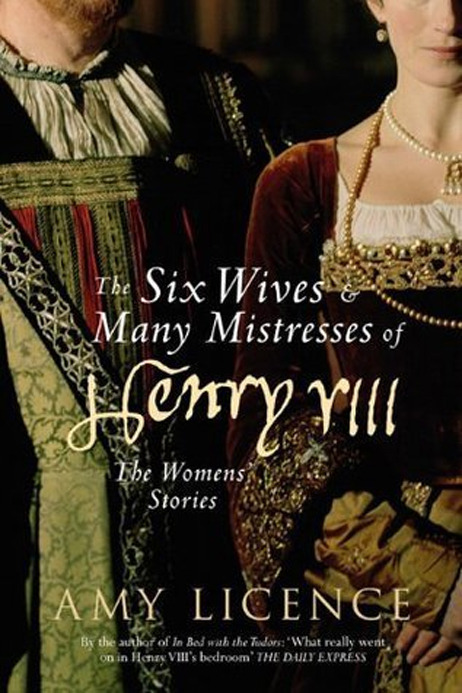

The 2008 film The Other Boleyn Girl had an unusual task when it began production. Showtime’s television series The Tudors was filming its second season at the same time, and due to the size of its cast, had rented out nearly every Tudor era garment available from costume houses around the globe. This meant that the film’s costume designer Sandy Powell, who has worked on previous costume dramas such as The Young Victoria and Interview with the Vampire, would have to create all of the costumes (with a few minor exceptions) from scratch. It is somewhat rare for a film to have to produce all costumes for main characters and extras, not to mention extremely costly. Powell had to stretch her budget even farther than would normally be required.
This russet colored velvet gown was created for The Other Boleyn Girl by Powell, where it was worn by Juno Temple as Jane Boleyn, Viscountess Rochford, though it is barely seen, and always in a darkened room. Ironically enough, The Tudors rented the costume for use in its 2009 third season, where it was used on actress Emma Hamilton as Anne Stanhope and again in the 2010 fourth season on Sarah Bolger as Mary Tudor, though it was slightly altered in the front to give it a different look. In 2013 the altered version appeared in a BBC documentary entitled The Last Days of Anne Boleyn, where it was worn on Tara Breathnach as Anne Boleyn. A promo photo from the production went on to be used the very next year on a book cover - The Six Wives and Many Mistresses of Henry VIII by Amy License. Most recently the costume was seen in the second season of Lore, where it was worn by Ella Hunt as Lady Margit. The added decor on the bodice has been removed, but you can still see the holes in the fabric where it used to be.
Costume Credit: Cintia, Mim, Ricardo, Jeaniefranklins
E-mail Submissions: [email protected]
Follow: Website | Twitter | Facebook | Pinterest
#the other boleyn girl#juno temple#the tudors#sarah bolger#emma hamilton#the last days of anne boleyn#tara breathnach#the six wives and many mistresses of Henry VIII#amy license#lore#ella hunt#costume drama#period drama
467 notes
·
View notes
Text
Lookbook: Fancy Dresses For the Lady Beneviento
I was not planning this at all, because I can already hear Donna saying that any and all of this is far too glamorous, provocative, and easily makes one stand out in a crowd.
And to that I reply, “Look, it’s not my fault that Queen Alexandra of the United Kingdom, wife to King Edward VII, wore such extravagant gowns that are really beautifully done in blacks and purples.”
I will already go ahead and say that yes, the necklines on the majority of these dresses will need to be fixed, because I think Donna would likely have a panic attack or anxiety if she showed that much of her chest.
Anyways.
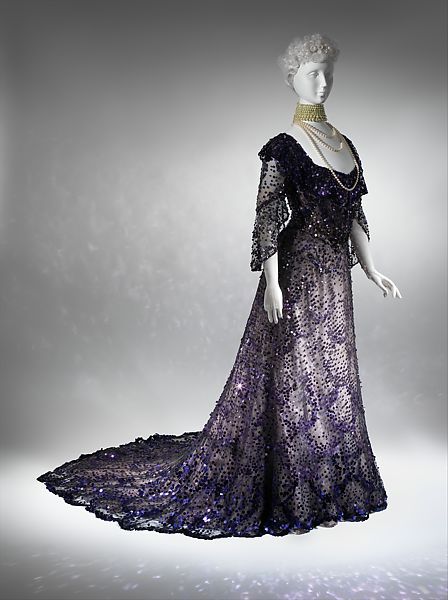

The dress that started it. Yes, I know, far too sparkly. Also, I wish it had a dark base rather than a light one, but it’s... it’s pretty and shiny and sparkly. And she would shine like a star and absolutely refuse to wear it. But as I said, it’s the dress that started the ball rolling. And, upon later research, this was a ‘half-mourning evening dress’ she wore after Queen Victoria died.
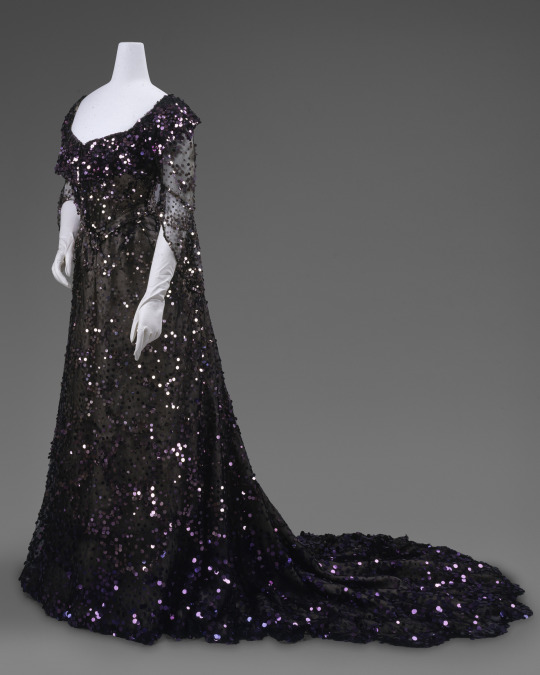
It’s quite likely that this is the exact same dress as above, but with either a different base under the dress (making it look darker) or a different lighting method. Either way, it somehow looks more appropriately Donna. Yes, more sparkly, but a darker sparkle.

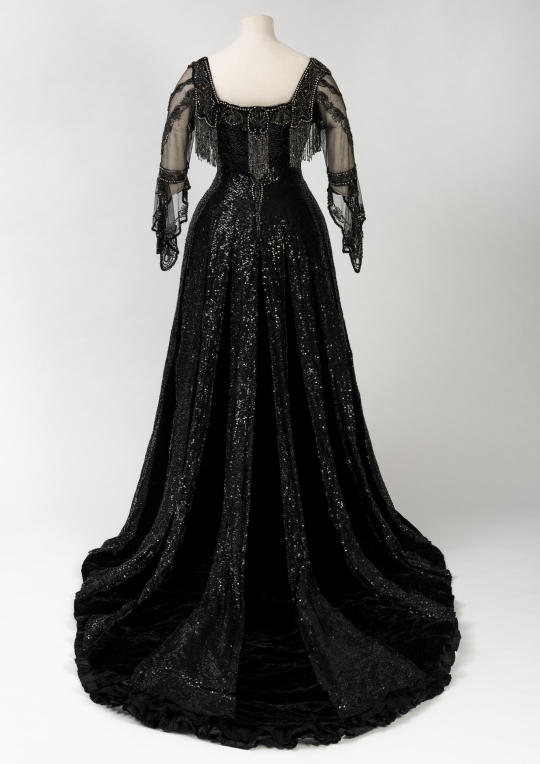
I don’t understand what they’re doing with the front of the bodice... or that bit that’s just pinned there under the breast, but dresses of the time were known to be altered in many ways, which is funny because you see this 119-ish year old dress and you think ‘don’t change a damn thing! It’s an antique!’ while to the wearer then they needed or wanted the most current style. so if beaded fringe was in, slap beaded fringe on that.
Anyways, the bodice is not what I’m focusing on, because look at the skirt. Two different fabrics, one likely a sequin fabric and the other a velvet. The sleeves are lovely with their sheerness and lace insertions, but again, would Donna show more skin than her hands?It’d take a lot of convincing and bribing.
Upon further examination, can we just admire the detail work of the bodice?
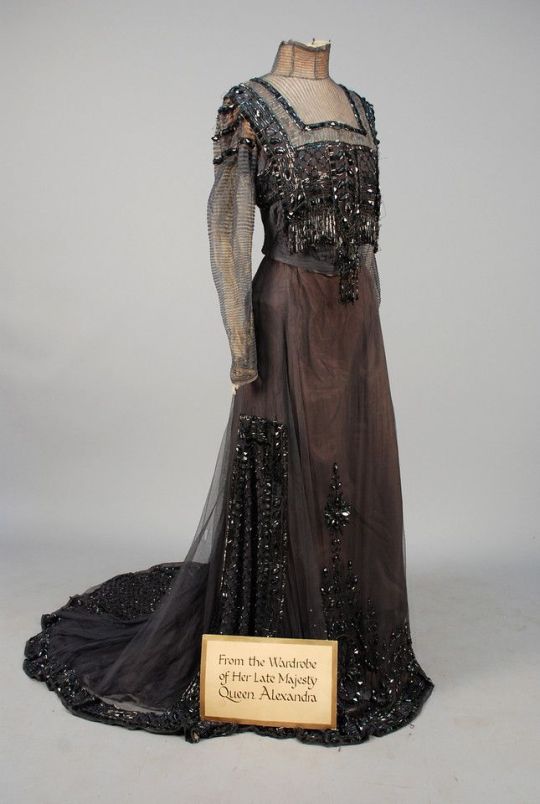
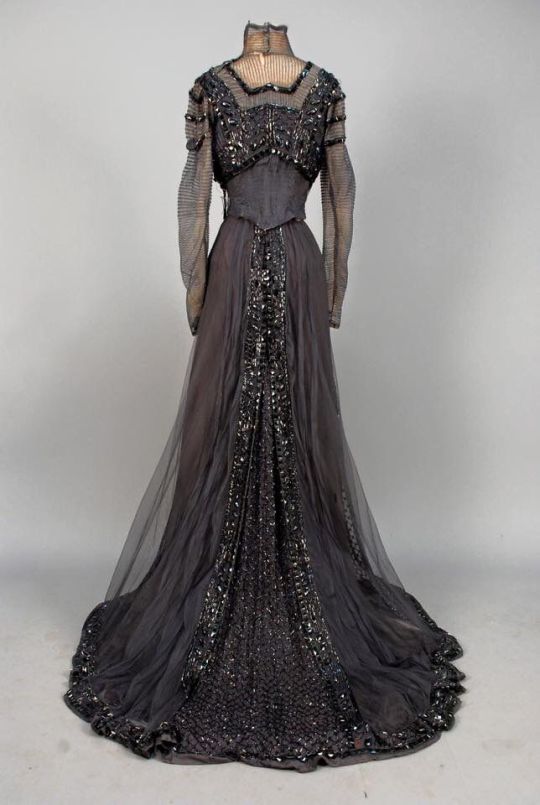
Again, I am not sure what the hell is going on with the chest. Queen Alexandra sewed and did enjoy Parisian fashion. Her mother-in-law was Queen Victoria, so perhaps all this glitz was a way to defy Victoria, who, if you didn’t know, wore mourning clothes after the death of her husband Prince Albert. For forty years. This extended to the court for at least a year or two. Of course, this could also be a dress from the mourning period for Victoria’s death, since after wearing black for a year, you could wear grays and purples.
Anyways, bodice front and that odd chunk on the side of the skirt aside (maybe this all looks wonderful in person), I love the grey-purple color, the two layer skirt (especially the glitz on the back and along the hem), and the general shape of the dress. Long sleeves and high collar are a nice respectable touch. Tone down the beading in other areas and I believe this could be worn.
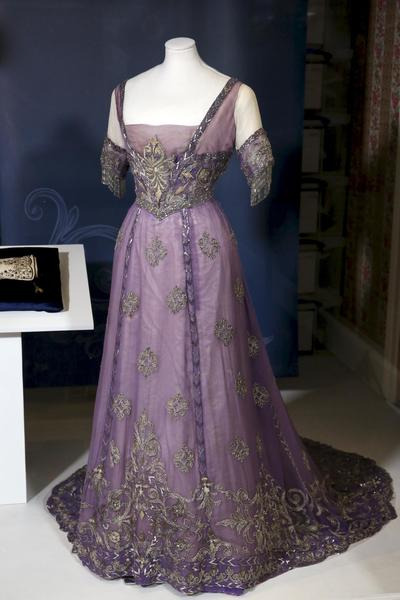
Donna, you’re wearing this. Yes, it’s a bright lilac, and the neckline is highly questionable (again, either ill fitting dress form, alterations happened, or foundation garments changed the drape immensely), but look at it. The gray-silver embroidery? Have it be of flowers from Donna’s garden, with perhaps just a hint of yellow or gold threads mixed in. Maybe embroider the house crest on the center bodice panel. Either way, I think Donna would be gorgeous in this.
( @donnabeneviento-doll)
#donna beneviento#potential fashion ideas#pretty dresses#Donna is a darker sparkle#Just thinking of ideas for her because I'm braindead
33 notes
·
View notes
Text
Experience the Convenience of a Service Wash at Leons Dry Cleaners
Let Leons Dry Cleaners in Victoria, South West London, take the stress out of laundry with our professional service wash. Whether you’re managing a busy lifestyle or just want the luxury of fresh laundry without the effort, we’re here to help.
Our service wash in Victoria is a complete laundry solution where we take care of everything for you. Simply drop off your laundry, and we’ll handle the washing, drying, and folding with care and attention to detail.
#wedding dress dry cleaning#curtain cleaning service victoria#dry cleaning pick up and delivery victoria#household cleaning services victoria#garment alterations victoria
0 notes
Photo
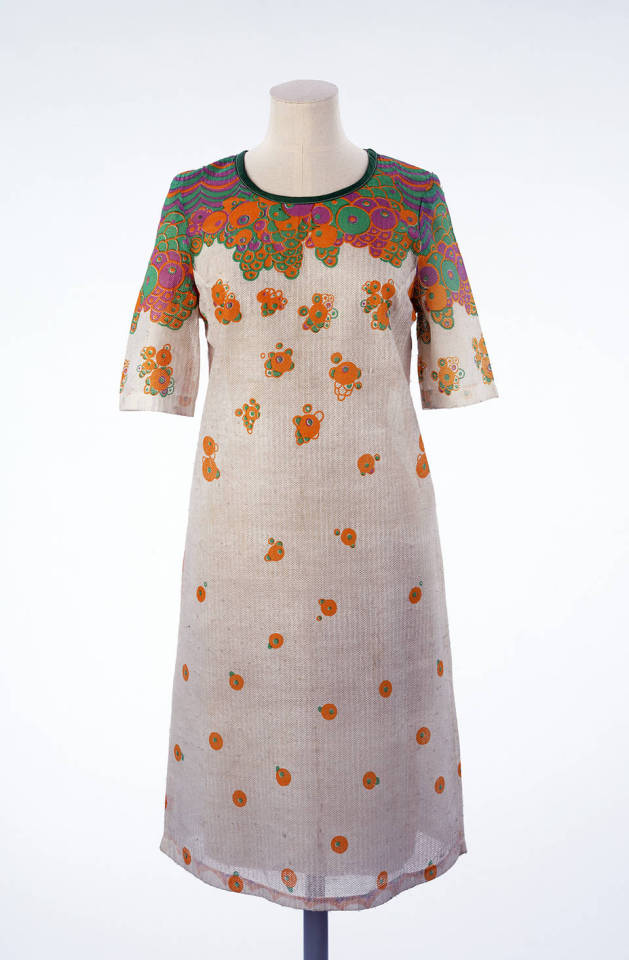
Paper Dress
Ossie Clark and Celia Birtwell
1966
The fashion world in the US and then the UK adopted the paper dress as the answer to the decade's restless appetite for 'the new'. Labels such as Poster Dress, Wastebasket Boutique and Dipso were dedicated to producing fast-changing ranges of disposable garments that allowed customers to easily stay abreast of trends. Designers like Ossie Clark also launched their own range of 'throwaways'. At the height of demand, Mars Hosiery (the makers behind Wastebasket Boutique) was producing 100,000 dresses a week. The 'no sew' nature of paper dresses made them a good fit for female consumers keen to reject the 'Make Do and Mend' attitude of the previous generation. Paper dresses could be altered in minutes with scissors and Sellotape: much more fun than spending a night in with your sewing basket. And for those young women who were keen to explore the decade's increasing freedoms, going out in a dress that was blatantly easy to tear off posed an exciting way to underline the new sexual politics.
Victoria and Albert
#paper dress#fashion history#vintage fashion#ossie clark#1960s#celia birtwell#20th century#white#orange#united kingdom#dress#1966#british#v and a#victoria and albert
544 notes
·
View notes
Note
So, I’ve been wondering this for a while and now seems like the time to ask, as I’m watching The Duchess: how did pregnancy figure into historical fashion? Georgian/Regency/Victorian/Edwardian dress seems ill-suited for such an extended period of many women’s lives. Was dress relaxed? Were women just never seen? I really can’t figure out how it would work because it seems like any logical reason isn’t extreme in the “historical” mind and nothing extreme is logical. Help!
A very reasonable question, and one that has a series of long and varied answers that I’ll try to condense.
Note that, while this is a woman-centered ask and response, people of other genders can of course become pregnant. But since basically no evidence exists about what the lone western trans man we know gave birth did during his pregnancy, and the Public Universal Friend never had kids, and women have made up the vast majority of pregnancies throughout history, I’m going to focus on them here.
The shortest version of the answer is that women made accommodations for pregnancy in their clothing (professional seamstresses and home dressmakers alike). Yes, in that time period. Yes, that one, too. In pretty much every time period you can think of, there have been maternity outfits- or everyday women’s clothes that can be easily adjusted for an expectant mother.
To go into more detail: first, no, women were generally not expected to seclude themselves for an entire pregnancy. Any woman who could afford to do so would generally take to her bed right around her expected time of delivery, but depending on the person, she could be actively engaging in public life almost until she had her baby.
I’ve read one letter from the 1810s that mentions a fancy dinner party being cancelled because the hostess went into labor. Really. So she intended to socialize/run an event while nine months pregnant, and everyone else seemingly considered that completely normal.
There are a lot of myths floating around about this, mostly because Queen Victoria didn’t like seeing pregnant women (she found it animalistic) and people have retroactively applied that to eras before her reign AND everyone who lived during it, but they are just that- myths.
Through the eras you mention, there were a few options available to pregnant women:
- Maternity stays/corsets. Some people wore special purpose-made models. Some just laced the bottom sections of their support garments looser and looser as their pregnancies progressed, and/or went without them entirely in the last stages. Though of course, whether one could forgo a boned support garment relied on the same criteria as not wearing a bra today (with bonus lessened ab and back muscle tone from years of external support).
- Clothing that’s just naturally easy to adjust for a changing body. You see this a lot with working-class women in particular for most of history, though in some eras even the fashions of the elite fell into this category. Parts of the 18th century are good examples, though if I list them all, we’ll be here for hours.
- Purpose-made maternity clothes. These appear in a lot of eras, though I suspect fewer survive in their original states than actually existed. Why? Well, when modifying your clothes at home is a normal part of life, and you don’t need maternity clothes anymore or pass a maternity garment down to someone who isn’t pregnant, it gets altered.
I think the fact that these things were usually made by women, for women (sometimes by the specific women who would also wear them) probably led to a lot of the clever adaptations we see on extant garments. Likely many more that haven’t survived, too.
People have always been people, as I like to say. And pregnant people have always needed to get about their business.
#ask#anon#pregnancy#history#women's history#fashion history#dress history#maternity clothes#long post
142 notes
·
View notes
Photo
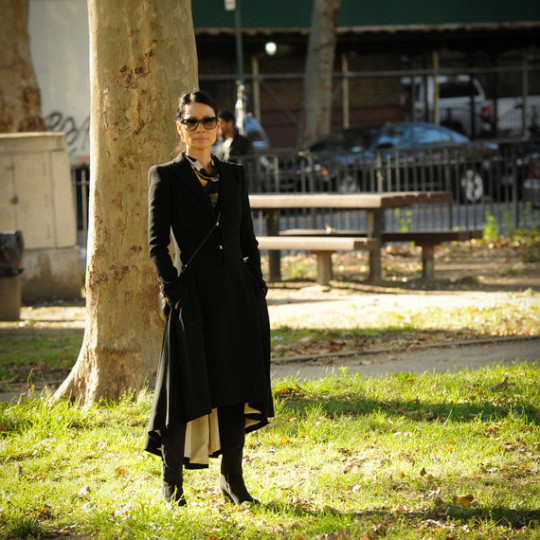

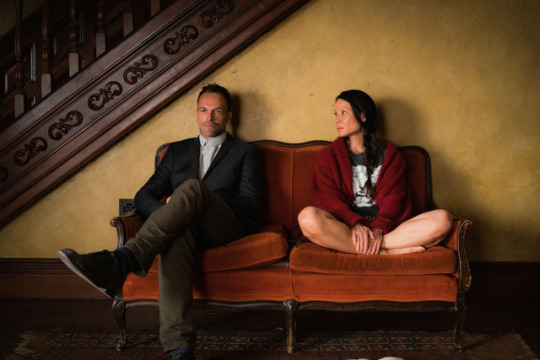
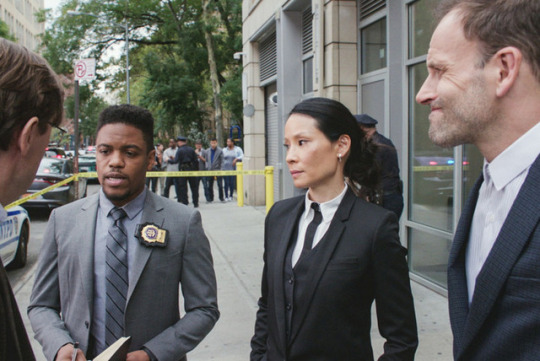
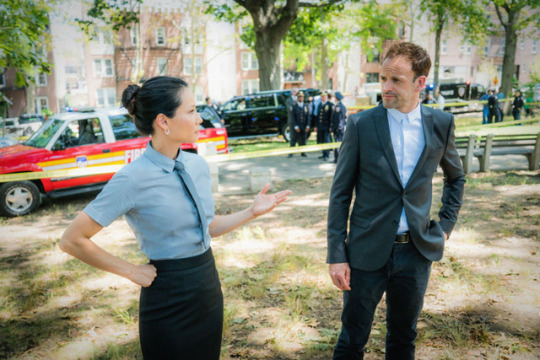

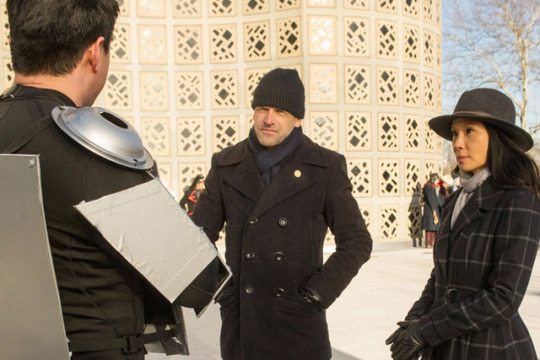

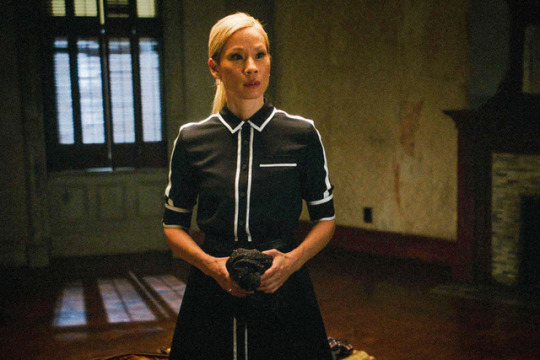

Vulture: Elementary’s Joan Watson Is the Best-Dressed Detective on TV
In the seventh and final season of Elementary, Joan Watson is blonde. The character’s style has constantly evolved alongside her detective career and partnership with Sherlock Holmes (Jonny Lee Miller), but in all her years on the show, there has been very little change to Lucy Liu’s locks. With just 13 episodes left, though, Joan has drastically altered her hair, which in turn means one last style shake-up for the best-dressed detective on TV.
Credit for that goes to costume designer Rebecca Hofherr, who has worked on the CBS procedural since its second episode in 2012, and who has guided Joan’s transformation from predominantly casual-leaning clothing to more structured menswear-inspired pieces. Hofherr spoke to Vulture about the narrative and fashion influences behind Joan’s costume evolution, including how they put their own stamp on an iconic duo and the sartorial challenges of shooting a 20-plus-episode season in New York City.

Joan’s styling was much more relaxed in the first year of Elementary. As his sober companion, her relationship with Sherlock was initially a professional commitment. She was not yet a detective and she was very much in the background of the investigation scenes. “Her clothing was very casual because that’s what the job called for,” Hofherr says. As Joan got more versed in the crime-solving world, her role shifted from sober companion to Sherlock’s protégée. By the second season, her costuming moved toward a slightly more sophisticated and buttoned-up approach. “As cheesy as it might sound, you need to put on a little more armor when dealing with the NYPD and all these criminals,” says Hofherr.
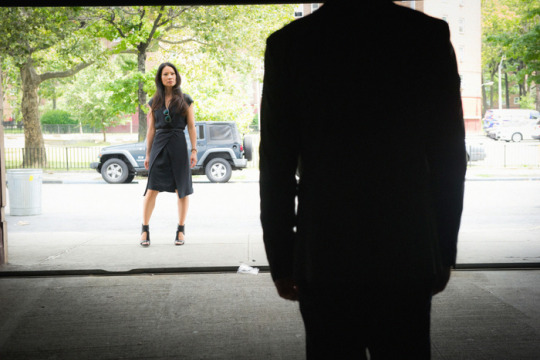
Joan’s wardrobe isn’t an either/or between suits and dresses, or even casual and business attire. She didn’t become a detective and suddenly stop wearing comfortable clothing. The suits reflect a change in Joan’s status and independence as an investigator, but dresses and sandals are still a vital style ingredient. During one Hofherr’s first conversations with Liu, they agreed Joan should “feel like a real New Yorker.” Expanding on this, Hofherr included staple items such as blazers or sandals, which most women have in their closets to dress an outfit up or down. “It was really nice to be able to incorporate them into a professional world for Joan,” she says.
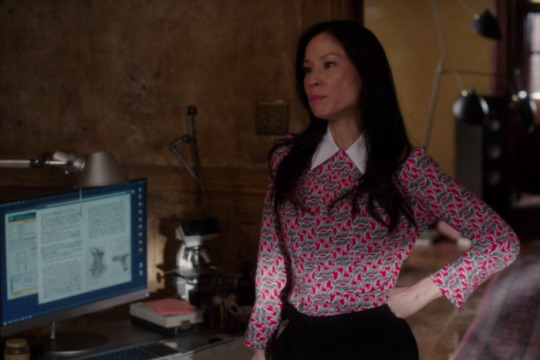
Discovering the true cost of a TV character’s wardrobe is an eye-opening experience. Joan’s closet is definitely packed with high-end items — Hofherr’s go-to favored designers for Joan include Victoria Beckham, Saint Laurent, Isabel Marant, and Stella McCartney, with Rag & Bone as her signature bootee choice — but to ensure her clothing reflected that New Yorker aspect, Hofherr also shopped at Zara and H&M. “It was really important to do a mix,” she says. “I think that’s pretty much how everyone shops. I don’t think it’s realistic to only shop at high-end stores.”
Noticeable costume repeats tend to be outerwear, but Hofherr also uses staple investment pieces such as high-waisted black pencil Victoria Beckham pants. (Dressing them with an inexpensive top, she adds, is “a great way to get a lot of outfits out of a really expensive pair of pants.”) There is an aspirational element to Joan’s garments, but the high-low mixing reflects how a lot of people shop. Hofherr also notes with a laugh that “pretty much everything Lucy wore from Zara, I also own. I was like, Oh, I can afford that.”
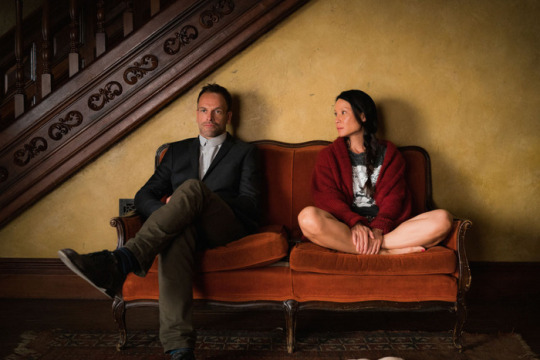
The one item that has appeared in all seven seasons? Joan’s red men’s Elder Statesman “house sweater.” Most people have a cozy garment that they only wear in the comfort of their own home, Hofherr explains, and Joan is no different. Sherlock and Joan’s brownstone home doubles as their office, but she wouldn’t be wearing suits at all hours of the day and night while solving a case. As Liu has worn this sweater so many times on the show, Hofherr says that not only has it molded to her body but it also has the pulls of a well-loved garment. It is also a color Joan doesn’t typically wear, which visually makes it a “nice change.”

Joan doesn’t eschew color, but a black-and-white motif runs through the first season to the last. Regardless of whether it is a suit, skirt, or a more casual outfit, sticking with the same color tone allows for experimentation with pattern. In the above outfit from season four’s “The Games Underfoot,” she wears a Saint Laurent polka-dotted tie with a checkered J.O.A. skirt and polka-dotted Ji Oh blouse. Sometimes the costume choice reflects Joan’s career, but on occasions like this one, it shows that Joan has a “fashionable side” too. “She can throw these things together and look really cute,” Hofherr says.
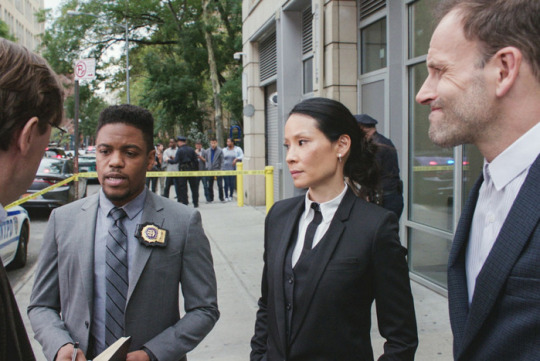
Two big style turning points emphasize Joan’s drive for equal footing with Sherlock as a detective. First came the ties, introduced at the end of season three. Suits followed, making their initial sartorial stamp in season five. The message is clear: Long gone are the days when Joan was Sherlock’s student. As with a lot of Joan’s costuming, she doesn’t stick to one specific suit-and-tie combo. In fact, the Marc Jacobs shirt above (which Hofherr got from one of her go-to sites, Shopbop) is a bit of an optical illusion, as it doesn’t even include a tie. Vests were thrown into the mix after Hofherr made the decision to stick with suits. It is also a nod to her relationship with Sherlock: Up to this point, Hofherr points out, vests have been Sherlock’s thing, so this costume mirroring is “a little nod to her respecting him so much.”
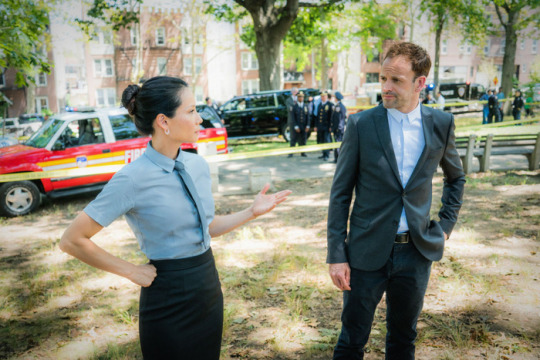
“I went to all ends of the Earth!” Hofherr laughs when talking about the many ties Joan has worn on Elementary. Men’s offerings were out of the question for someone of Liu’s stature, as they are just too wide and long. She snapped up everything Saint Laurent and Gucci had on offer, but she also shopped at uniform companies, bought a few kids’ ties, and even made them in-house. Maybe a Joan Watson tie line should be next? “If all these designers are going to sell women’s suits, I would love for them to start making women’s ties,” Hofherr suggests.
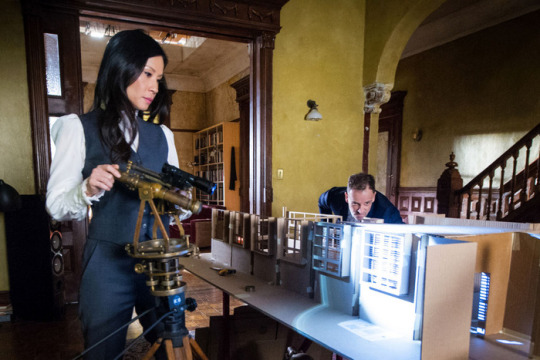
Another later costume addition was the Victorian-style Isabel Marant blouse. In part, this outfit was a hat tip to the original Holmes and Watson, but it also added another variation on the suit theme. One of the biggest challenges when doing a show with a full 20-plus-episode order is obtaining enough clothing, particularly for a fashion-forward character like Joan. Hofherr says that she needs 50 outfits a month — on average, Joan has five changes per episode — and costuming was made trickier because designers don’t typically replenish their collections between seasons. “We end up making a lot of clothes based on designs we love and change a few things because I can’t find 20 Victorian-style blouses or 20 men’s-style blouses,” Hofherr laments. “I can find five, but then that’s it for four months.”
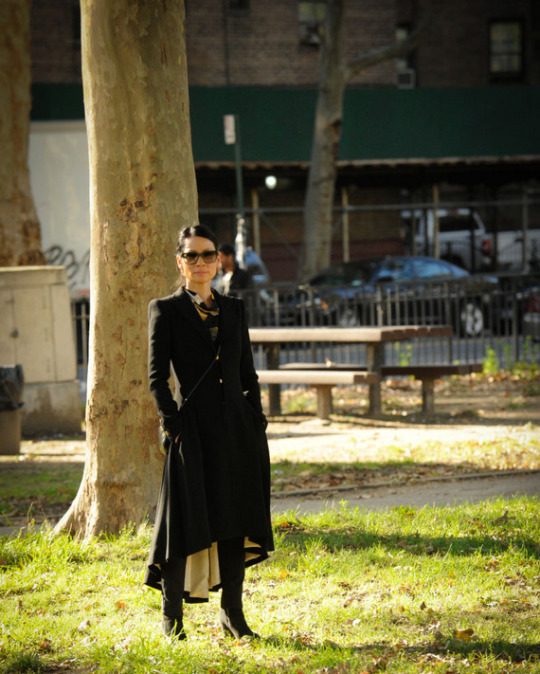
Fashion seasons are not the only Elementary costume challenge, as shooting outside in New York City from July to May means having to find clothing that fits all weather cycles. (The 13-episode final season was a bit easier, though, because they only shot until December.) Sherlock sticks to the same styles — “This guy would buy 20 of the same shirts, the same sport coat, and the same pants,” Hofherr says — and he has also worn the same Tom Ford winter peacoat for seven years. On the flip side, Joan has many changes, but she isn’t going to have a different coat for each outfit, as that is neither practical or realistic for either the character or the designer. Hofherr’s preference was to have between five and ten on hand: “If we got the coats fitted and ready to go we could just recycle them episode after episode.” Outerwear is something that is repeated across various seasons — including the Alice + Olivia coat above — but accessories like hats, gloves, and scarves are switched out to keep things fresh.
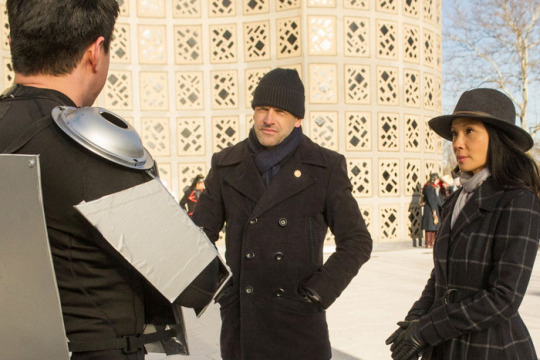
Sometimes the weather also dictates the type of hat required: “I originally got that hat because we were shooting outside one day in the rain and they didn’t want to have umbrellas,” Hofherr says. The wider brim of this Barneys-brand men’s hat has since been worn on a number of occasions, as has the tie-waist Marissa Webb windowpane check coat (which will reappear in the final season).
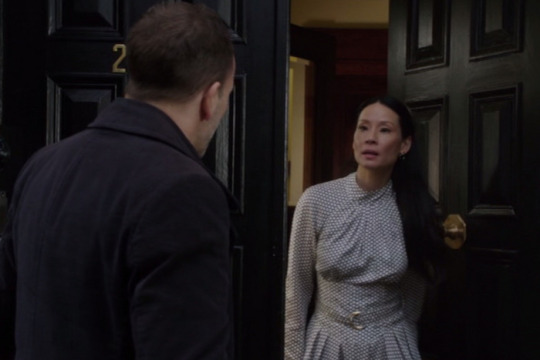
Of course, the story also dictates what Hofherr chooses for Joan. At the end of season six, creator Rob Doherty didn’t know if they were going to get renewed, so they shot two different endings. This particular Diane von Furstenberg dress fit both the ending we saw and the alternative they filmed — though Hofherr couldn’t provide any other details without spoiling the end of season seven as well. “I wanted it to be timeless, as I didn’t know if it was the last time we were ever going to see Joan Watson,” she says. “It was a little bit of an ode to all the Joans we have seen throughout the seasons. I felt a suit would have been a different look for that final scene.” No surprise, then, that it is also one of Hofherr’s costume highlights.
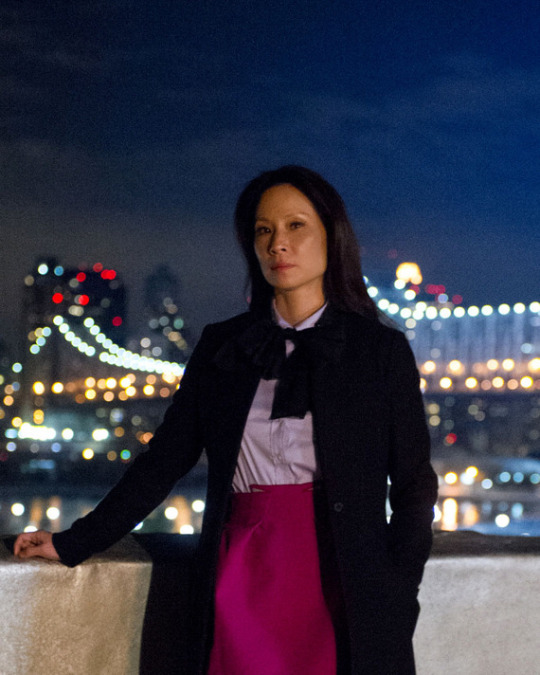
Hofherr couldn’t pick a single favorite outfit, but this one she considers to be the most significant. At the end of season three, Sherlock has almost killed a man and relapsed, but Joan’s loyalty doesn’t waver. “This is where we start to see the Joan that we will forever know,” says Hofherr. “And I think this is the best version of Joan too.” The pink skirt is by Roland Mouret and the shirt is Uniqlo, which is another high-low outfit mix. It also happens to be the first time Joan wears a tie, which is a huge style turning point.

Hofherr also spoke in depth about working with Liu, not only as an actress but in her role as a director. (She has stepped behind the camera six times on Elementary.) Referring to Liu as “one of the most inspirational women I’ve had in my life” — she also did the costume design on the Liu-starring Netflix rom-com Set It Up — she says Liu is “willing to take risks, but she knows exactly when to take them.”

Which brings us back to the blonde mystery. Hofherr had already FaceTimed with Liu sporting her new hair color, but the styling was a task of its own. “She walked in for her first fitting of the final season and I didn’t recognize her,” said Hofherr laughing. They did plan fewer outfits than previous seasons’ fittings, she adds, “because we were figuring out what works with the blonde hair and what doesn’t.” Don’t worry: There are still plenty of outfits to come, particularly in the last two episodes. (Hofherr teased that Joan will have ten-plus changes.)
The signature black-and-white motif remains, including these fabulous Stella McCartney palazzo pants. “I always know it’s a really good outfit when all the crew members ask me what it is,” Hofherr says. That is the exact reaction Liu got when she stepped on set in this particular costume.
#joan watson#lucy liu#rebecca hofherr#elementary#elementasquee#behind the scenes#who dresses you girl#i think what you do is amazing#read more
1K notes
·
View notes
Photo


Early Mid Modernism
The coat was a garment made in England 1705-1715 (The V&A Collection: Fashion, 2020). Descended from the cassock, it was introduced by King Charles the 2nd to prevent the English from wearing French styles (The V&A Collection: Fashion, 2020). Cassocks were full-length garments that were worn by members of the church (Minor, 1884). The coat would have been made from wool because Britain was the biggest exporter of wool and it was an alternative to using silk for the upper classes (The V&A Collection: Fashion, 2020). It would be worn directly on top of the shirt and the coat sleeves were slightly shorter than the shirt sleeves (The V&A Collection: Fashion, 2020). The coat also had buttons from collar to hem (The V&A Collection: Fashion, 2020). The silk yellow sack back dress and plain petticoat was woven in England 1710, sewn in 1760 and altered between 1870-1910 (The V&A Collection: Fashion, 2020). The front of the sack back dress is open, the waist has robings and the elbow-length sleeves are double pinked and have scalloped sleeve ruffles (The V&A Collection: Fashion, 2020). Robings are trimmings, usually around the neck and bodice (Minor, 1884). Pinking is a technique that cuts a scalloped or zigzag edge and scalloped is a decorative technique (Minor, 1884). The sack back dress is made from four layers of silk with a panel on each side of the front (The V&A Collection: Fashion, 2020). The waist seam starts from the front opening and ends at the bodice side-back seam, where the skirts are flat-pleated (The V&A Collection: Fashion, 2020). There are hidden pockets in each side of the sack back dress (The V&A Collection: Fashion, 2020). The lining in the bodice is made from linen (The V&A Collection: Fashion, 2020). The petticoat is made from five layers of silk (The V&A Collection: Fashion, 2020). The reason why the sack back dress and petticoat were altered between the late 19th and early 20th centuries was because they became a fancy dress rather than a dress that would be worn casually (The V&A Collection: Fashion, 2020). The parts of the sack back dress that were altered were the pleats, parts of the back-bodice lining and front linings (The V&A Collection: Fashion, 2020).
References
Minor, W. C. (1884). Oxford English Dictionary. Oxford: Oxford University Press.
The V&A Collection: Fashion (2020) [Exhibition]. The Victoria and Albert Museum, London. 4 December 2020 - 15 January 2021.
3 notes
·
View notes
Video
youtube
https://angiespanties.com/ In 2019 it will be a long time since Gossard's Wonderbra lingerie released what has been known as the "most notorious" advert ever: Ellen von Unwerth's high
contrast photo of Eva Herzigova looking down at her own superb cleavage over the legend, "Hi, young men." Recall it? Obviously you do. Soon thereafter, the starving
stray like Kate Greenery supported a similar push-up, cushioned bra in the New York Times, pronouncing that "even I get cleavage". In the interim in Soho, London,
Joseph Corré and Serena Rees were opening Agitator, a boldly sexual up market lingerie store whose advertisement crusades Greenery would later proceed to star in.
Likewise in 1994, Otherwise known as the Time of Our Cleavage, and because of Wonderbra's lingerie sensational elevate in deals, rival lingerie brand Victoria's
Mystery dispatched its first television advert. Versus has since become a worldwide behemoth, most popular for a yearly catwalk show where its models, or "heavenly
attendants", with staggering bodies and pushed-up bosoms – the most generously compensated of whom (models, not bosoms) have included Adriana Lima, Kendall
Jenner, Gigi Hadid and Joan Smalls – march the catwalks in their close to-nothings under according to first column visitors, for example, Leonardo DiCaprio, and a
worldwide television crowd of 500 million.
The push-up bra as instrument for (hetero-) sexual fascination has been the prevailing pattern in the ladies' lingerie market for the past quarter of a century. Be that as
it may, is its time up? A month ago Victoria's Mystery experienced harsh criticism for the absence of body-shape lingerie variety in its latest show (not helped by Ed
Razek, its head promoting official, disclosing to Vogue that he had no interest in transsexual models or depicting a more extensive scope of sizes and shapes), and there
is proof that the lingerie area is prepared to change into something more agreeable.
In 2017, Altered, a London-based retail innovation organization that tracks the dress business, noticed that dependent on an example of retailers in the US, UK and
Europe "deals of push-up bras have fallen by half contrasted with a year prior, while deals of bralette, or triangle bras, have soared by 120%." Uncovering that the
area's customarily most-supplied style, the cushioned bra, had fallen by over 20% in a similar period, Altered reported: "Women’s lingerie and courteous fellows, the
norm has left the structure."
"The meaning of provocative has developed," is the manner by which Heather Gramston, purchasing supervisor at Selfridge's Body Studio, the store's lingerie, hosiery
and active apparel division, puts it. "It is currently characterized as how a lady feels when she is wearing something – rather than what she resembles in original
women’s lingerie made in light of men. Ladies," she adds, "are driving this."
Five models in bronze-hued underwear
'I needed ladies to feel commended': models at Rihanna's Savage X Fenty Fall/Winter 2018 show during New York Style Week in September. Photo: Brian Ach/Getty
Pictures for Savage X Fenty
One of Selfridge's greatest image dispatches this year is Myla. Initially established in 2000, it was relaunched this year by previous President of Agitator Gary Hogarth.
Leila Habibi, Myla's item and gracefully chain chief and part of the first AP group, says of underwear during the 90s: "It was about the push-up. Now and again, my
boobs were pushed up so far that before the days over they'd jumped out."
Myla now utilizes the best French textures, however its styles and fits have moved with the occasions. Delicate bras with triangle cuts and bralettes in stretch trim
component, women’s sexy lingerie as do sportier outlines and pajama bottoms that you could wear out as much as remain in. In spite of the fact that they don't care for
utilizing the C-word (comfort) there's in excess of a recommendation of it. "Ladies need to feel like they can move around, be dynamic in their underwear, much the
same as they are in their garments. Furthermore, we have more established," says Habibi of the plan group. She brings up a bra with a higher, conceivably all the more
complimenting cut under the arm. "Our bodies have changed and we needed to mirror that in our cuts and shapes."
The meaning of attractive has developed... Ladies are driving this lingerie away from the conventional discount lingerie model; advanced local brands have been
driving change with another sort of informing, building solid online networks frequently revolved around body energy, inclusivity and variety. Agitator's Serena Rees,
drove by a more youthful crowd, has made Les Young ladies Les Young men, a "road to-bed" scope of underwear that can be worn as outerwear focused on sexual
orientation liquid recent college grads. It offers a more gritty interpretation of hotness for the Depop age, a sort of Gen Z Calvin Klein – despite the fact that gratitude to
a fiercely fruitful relaunch in 2014, which urged clients to post lo-fi attractive selfies with the hashtag #mycalvins, that brand is as yet a colossal part on the lookout.
The English name Beija London ventures to such an extreme as to guarantee it's "unquestionably not selling sex and lingerie." Sister authors Abbie Miranda and Mazie
Fisher have thought of an inventive reach where every bra is made in three forms to suit different shapes. "The item is unsexualised, just like the model postures on
the site, the hair, the make-up," says Miranda. "It's something contrary to Agitator. A few people are upbeat bossing their provocativeness, however that is not really
where you'd feel good going with your girl."
Computerized commitment permits clients to interface legitimately with brands and them to react appropriately. "What performs well for us on Instagram is if the
model has a smidgen of a move on her stomach," says Miranda. "It resembles seeing your hot companion. We'll get an additional hundred preferences for that more
practical picture."
A model sitting on a plinth in red 'body' lingerie seems to be very attractive to most men in 2020.
'Our bodies have changed and we needed to mirror that in our cuts and shapes,' says a representative for Myla (displayed over), one of Selfridges greatest brand
dispatches this year.
The body energy message seems, by all accounts, to be getting more grounded even as the years proceed onward. In 2016, the New Zealand name Desolate stood out
when Young ladies' maker/star Lena Dunham and star Jemima Kirke fronted its mission in un-retouched pictures. Moreover, the moderate underwear name
Baserange values its no-modifying strategy in its photography. Maria Yeung, originator of consistent underwear/swimwear line Marieyat accepts that lingerie is "tied
in with feeling great and positive about your own body and not tied in with changing the presence of your figure by pushing up or leveling resources".
Indeed, even the lingerie shape wear market is testing itself. In October, Heist, an English mark that has made its name with hey tech leggings in a scope of seven skin
tones and with a no dive in abdomen band, dispatched an online mission called #NoThanks, for which they shot joke artists including Instagram sensation Celeste
Stylist as they endeavored to battle into hard-to-arrange bodysuits. This was (normally) in front of the dispatch of its own shapewear bodysuit dispatch. Planned by
the Scottish presentation wear trend-setter Fiona Fairhurst, who designed the FastSkin bathing suit for Speedo, it utilizes film innovation instead of sewn creases and
no flexible groups so the underwear will move with the body as opposed to against it and won't cause an awkward ascent in internal heat level.
"We asked 1,025 ladies who wear shapewear lingerie for women what they needed to change and they were truly clear," says Fairhurst: "‘we don't' have any desire to
press, sweat or battle into something.'" Open to discussion and communication, the dispatch function incorporated a board conversation that posed the inquiry: is
shapewear against women's activist? "I don't think giving women’s underwear and lingerie that genuinely works, which moves with their bodies, which has been
brilliantly planned by ladies for ladies to be enabled and certain, can be portrayed as hostile to women's activist. Ladies ought to be permitted to do and be who and
what they need to be.
1 note
·
View note
Photo





Wedding outfit of dress, bonnet and cap worn by Sarah Fletcher and wedding waistcoat worn by James Kenyon, 1844
These clothes were worn by the couple for their marriage on 27th March 1844 in Bury Parish Church. The fashionably shaped but modest dress is typical of wedding clothing in the early Victorian era, and the dress also comes with an accompanying bertha and pelerine cape. These accessories would have been used to alter the look of the dress slightly and allow it to be worn in a few different styles. It was common to wear the wedding dress again after the wedding perhaps as a formal afternoon, reception or dinner dress. Queen Victoria is credited with a rise in the popularity of white wedding dresses after she wore a white gown for her wedding in 1849 but even after this middle and working class brides would often still choose a more practical colour that could be worn again afterwards more easily. During the 1840s soft pinkish browns like the shade seen on this dress were popular alternatives to white as were purplish greys, soft greens and pinks.
The dress fabric is a quality silk satin damask, probably woven on a jacquard loom, with a self-coloured pattern of jagged geometric shapes known as a ‘cracked ice’ pattern that was very fashionable during the early 1840s. The silk satin brocade used in James’ waistcoat is another good quality fabric with a beautiful lustre. The patterning of small sprigs of flowers interspersed with small blocks of zig-zag shading is again right on trend for the 1840s. William Kenyon was a linen draper, which probably explains the high quality and fashionable patterning of the fabrics used in both his waistcoat and Sarah’s dress. Further evidence of the good quality of the wedding garments is indicated by the perfectly colour matched passementrie trimmings on the dress and its accessories as well as the skilful tailoring of the waistcoat which included painstakingly pattern matching the fabric pattern on the pockets.
Sarah’s fragile plaited straw bonnet and even more fragile silk net and ribbon cap worn beneath it also survive. The smooth, finely plaited straw bonnet would have been an expensive item that would likely have been re-worn many times and well-looked after. Although simple in shape it has been tastefully decorated with handmade bobbin lace and a wide floral patterned silk ribbon that co-ordinates with the colour of the dress. Unfortunately, no other parts of James’s outfit have survived, likely because his suit was re-used until it was worn out.
The items were donated to the collection by descendants of James and Sarah Kenyon in 1964 but the names of James and Sarah themselves had not been recorded. Over the last few years we have been researching the people associated with many items in the collection and, not only were we able to trace the original couple who wore the clothes, we were also contacted by another descendant of the couple who was able to give us even more information about them. Of all the pieces we have researched so far this has certainly been the most fruitful.
These pieces were selected as part of The Collection in 60 Objects to celebrate 60 years since the founding of our charity. Use the tag #rbks60 to see the other items we selected.
3 notes
·
View notes
Text
A History

I learned to use a sewing machine and read a pattern from my mom when I was 10 years old, but I didn’t spend a lot of time sewing until high school. In high school I started to develop a sense of personal style, and I loved to buy clothes from thrift stores and make them over. I can’t seem to find any good photos, but I had a lot of fun.
In college, I got into costuming because Halloween, duh, and also the Opera Workshop had close to no budget for costumes and I cared a whole lot. For most of the shows, I purchased stock and altered it, but I did get to design and build two whole operas, a (very crappy) World Premiere set in biblical times and a Star Wars themed Magic Flute.

This is a halloween costume I made on the floor of my dorm from a scaled up 1960s pattern I inherited from my Memaw.
See more of my work past the cut!

The only photo I can find of the Darth Lady Maul as Queen of the Night costume I built for Star Wars Magic Flute.
Toward the end of college and through grad school I began to experiment with altering patterns so that I could make clothes that fit me well. I was quite prolific during that time and I learned a lot. A couple of the dresses I made then are still staples in my wardrobe years later. But there are a few others I’ve never been quite satisfied with.

I would still be wearing this if it fit! It also started to fall apart. I have it in my sewing closet to be fixed but I doubt I’d be able to get it zipped.

This green dress is one of the ones I would have kept in my wardrobe had I not gained a ton of weight in grad school.

I did not keep this long as I was never pleased with the fit.

I would be a lot more pleased with this gown if I had made it with more hand-sewing techniques. I still have this in my closet but it’s never been quite right.

I’m obsessed with this fabric, but unfortunately I made this without a mockup and the fit is largely improvised. The waistband sits WAAY too high, but only in the front, which is a shame because the sleeves fit so perfectly. I’m saving this to re-fashion as a skirt!

I wear this floral dress regularly. It’s super comfortable in rayon challis, and made from another Memaw pattern from the 1970s.

I will wear this dress until it is worn out completely. It’s still the best modern garment I have ever made.
When I met my now-husband, he introduced me to renaissance festivals, and I became interested in medieval fashion. I made my first kirtle (grey linen/rayon, inspired by late 14th century kirtles) for one of his birthday parties, and I fell in love. That kirtle is the most comfortable dress I have worn to date, and the fit is what convinced me I need to find a way to get rid of all of my bras. I ended up patterning my wedding dress after the grey kirtle.

This is my basic kit, which consists of my first grey kirtle (front lacing) and this orange surcoat (the first thing I drafted from scratch), both in linen/rayon from JoAnn, with my husband’s viking king tunic in the same fabric.

This was a practice wedding dress. It is made of polyester and zips in back.

The final wedding dress. My pride and joy. Made of 100% silk charmeuse flat-lined with linen/rayon. I hand-felled every seam and the hem and made 100 buttons in the medieval way. I saw the pictures and exclaimed “I look like one of the paintings!” Have a couple more photos:




Through my kirtle experiments I found costube and I am now coveting a whole slew of historical fashions, primarily Late Medieval, Georgian, and Regency (although the ITV/PBS show, Victoria, has stretched that bound to about 1845). I am trying to figure out what I want to prioritize.
When I started getting serious about sewing in grad school I decided I wanted to gradually replace my wardrobe with home-sewn clothing. I am nowhere near achieving this goal, but as I am continuing to hone my style and learn about fit and construction, I feel I can get underway. My style has always been eclectic, so I am having a bit of trouble deciding what exactly I want... except that I want something more cohesive.
#sewing#sewing diary#personal#design#fit#me made#medieval#kirtle#wedding dress#historybounding#sewist
10 notes
·
View notes